Effect of the Hydrogen Injection Position on the Combustion Process of a Direct Injection X-Type Rotary Engine with a Hydrogen Blend
Abstract
1. Introduction
2. Models Establishment and Verification
2.1. Establishment of Geometric Model
2.2. Mathematical Model and Boundary Conditions
2.3. HB Method and Nozzle Positions
2.4. Model Validation
3. Results and Discussion
3.1. Flow Field Distribution and Mixture Formation
3.2. Combustion Process Analysis
3.2.1. In-Cylinder Flame Propagation
3.2.2. Overall Combustion Performance of Engine
3.3. Emission Process Analysis
4. Conclusions
- (1)
- The interaction between the in-cylinder flow of the mainstream flow field and the hydrogen injection affects the distribution of hydrogen gas before ignition. On the one hand, due to the influence of the hydrogen injection, a large vortex is formed in the injection direction. On the other hand, the vortex makes the hydrogen mix faster with the gas. When the injection position is from the front to the back of the combustion chamber, namely position 2, the hydrogen thick distribution area in the cylinder is the largest and closest to the ignition position.
- (2)
- The different injection position leads to different in-cylinder hydrogen distribution, which affects the combustion area and combustion rate after the stable flame kernel is formed. Furthermore, position 2 presents the largest combustion area, leading to the highest in-cylinder peak temperature of 1835.16 K and cycle work of 14.90 J. Compared to position 4 that has the lowest thermal efficiency of 24.13%, position 2 presents the highest thermal efficiency of 26.56%, which is 10.08% higher than that of position 4. Thus, it is suggested to drill nozzles at position 2 for injecting hydrogen in the practical work.
- (3)
- Position 2 shows the most intense combustion, resulting in its CO generation speed being the fastest. Meanwhile, its highest combustion completeness leads to its lowest final unburned carbon emission of 0.36 mg. Although the combustion speed in the pre-combustion period is fast at position 3, the in-cylinder temperature drops obviously in the post-combustion period. Therefore, the incomplete combustion of position 3 in the post-combustion period results in the highest unburned carbon emission of 0.42 mg. The NOx emission of position 2 is the highest at 9.15 μg due to its higher temperature. Meanwhile, the differences in carbon soot emission quality among the different positions are not noticeable. Thus, it can be concluded that carbon emissions can only be minimized by controlling the complete combustion of the whole combustion process.
- (4)
- In the future, the influences of hydrogen injection timing, secondary injection, injection nozzle diameter and other factors on XRE overall performance with hydrogen–gasoline fuel will be conducted.
Author Contributions
Funding
Data Availability Statement
Acknowledgments
Conflicts of Interest
Abbreviations
| XRE | X-type rotary engine |
| WRE | Wankel rotary engine |
| HEHC | high-efficiency hybrid cycle |
| CFD | Computational Fluid Dynamics |
| HB | hydrogen-blended |
| DI | direct injection |
| PI | port injection |
| RPM | Revolutions per minute |
| CA | crankshaft angle |
| BTDC | before top dead center |
| ATDC | after top dead center |
| HRR | Heat Release Rate |
References
- Ohkubo, M.; Tashima, S.; Shimizu, R.; Fuse, S.; Ebino, H. Developed Technologies of the New Rotary Engine (RENESIS); SAE Technical Paper; SAE: Warrendale, PA, USA, 2004. [Google Scholar]
- Wang, W.; Zuo, Z.; Liu, J. Miniaturization limitations of rotary internal combustion engines. Energy Convers. Manag. 2016, 112, 101–114. [Google Scholar] [CrossRef]
- Sadiq, G.A.; AL-Dadah, R.; Mahmoud, S.M. Development of rotary Wankel devices for hybrid automotive applications. Energy Convers. Manag. 2019, 202, 112159. [Google Scholar] [CrossRef]
- Shivaprasad, K.V.; Raviteja, S.; Chitragar, P.R.; Kumar, G.N. Experimental Investigation of the Effect of Hydrogen Addition on Combustion Performance and Emissions Characteristics of a Spark Ignition High Speed Gasoline Engine. Procedia Technol. 2014, 14, 141–148. [Google Scholar] [CrossRef]
- Siadkowska, K.; Wendeker, M.; Majczak, A.; Barański, G.; Szlachetka, M. The Influence of Some Synthetic Fuels on the Performance and Emissions in a Wankel Engine); SAE Technical Paper; SAE: Warrendale, PA, USA, 2014. [Google Scholar]
- Shkolnik, N.; Shkolnik, A.C. Rotary High Efficiency Hybrid Cycle Engine); SAE Technical Paper; SAE: Warrendale, PA, USA, 2008. [Google Scholar]
- Shkolnik, N.; Shkolnik, A.C. High Efficiency Hybrid Cycle Engine. In Proceedings of the Internal Combustion Engine Division Spring Technical Conference, Aachen, Germany, 7–10 May 2006. [Google Scholar]
- Yang, Z.; Du, Y.; Geng, Q.; He, G. Energy loss and comprehensive performance analysis of a novel high-efficiency hybrid cycle hydrogen-gasoline rotary engine under off-design conditions. Energy Convers. Manag. 2022, 267, 115942. [Google Scholar] [CrossRef]
- Shkolnik, A.C.; Shkolnik, N.; Scarcella, J.B.; Nickerson, M.D.; Kopache, A.; Becker, K.F.; Bergin, M.J.; Spitulnik, A.N.; Equiluz, R.; Fagan, R.; et al. Compact, lightweight, high efficiency rotary engine for generator, APU, and range-extended electric vehicles. In Proceedings of the NDIA Ground Vehicule Systems Engineering and Technology Symposium, Novi, MI, USA, 7–8 August 2018. [Google Scholar]
- Nickerson, M.D.; Kopache, A.; Shkolnik, A.C.; Becker, K.F.; Shkolnik, N.; Bergin, M.J.; Spitulnik, A.N.; Mikhailov, K.A.; Equiluz, R.; Fagan, R.; et al. Preliminary Development of a 30 kW Heavy Fueled Compression Ignition Rotary ‘X’ Engine with Target 45% Brake Thermal Efficiency. In Proceedings of the WCX World Congress Experience, Detroit, MI, USA, 10–12 April 2018. [Google Scholar]
- Leboeuf, M.; Dufault, J.-F.; Nickerson, M.D.; Becker, K.F.; Kopache, A.; Shkolnik, N.; Shkolnik, A.C.; Picard, M. Performance of a Low-Blowby Sealing System for a High Efficiency Rotary Engine); SAE Technical Paper; SAE: Warrendale, PA, USA, 2018. [Google Scholar]
- Littera, D.; Nickerson, M.D.; Kopache, A.; Machamada, G.; Sun, C.F.; Schramm, A.; Medeiros, N.; Becker, K.F.; Shkolnik, N.; Shkolnik, A.C. Development of the XMv3 High Efficiency Cycloidal Engine; SAE Technical Paper; SAE: Warrendale, PA, USA, 2015. [Google Scholar]
- Costa, T.; Nickerson, M.D.; Littera, D.; Martins, J.; Shkolnik, A.C.; Shkolnik, N.; Brito, F.P. Measurement and Prediction of Heat Transfer Losses on the XMv3 Rotary Engine. SAE Int. J. Engines 2016, 9, 2368–2380. [Google Scholar] [CrossRef]
- Dincer, I.; Acar, C. Review and evaluation of hydrogen production methods for better sustainability. Int. J. Hydrogen Energy 2015, 40, 11094–11111. [Google Scholar] [CrossRef]
- Raviteja, S.; Kumar, G.N. Effect of hydrogen addition on the performance and emission parameters of an SI engine fueled with butanol blends at stoichiometric conditions. Int. J. Hydrogen Energy 2015, 40, 9563–9569. [Google Scholar] [CrossRef]
- Shadidi, B.; Najafi, G.; Yusaf, T. A Review of Hydrogen as a Fuel in Internal Combustion Engines. Energies 2021, 14, 6209. [Google Scholar] [CrossRef]
- Duan, X.; Liu, Y.; Liu, J.; Lai, M.-C.; Jansons, M.; Guo, G.; Zhang, S.; Tang, Q. Experimental and numerical investigation of the effects of low-pressure, high-pressure and internal EGR configurations on the performance, combustion and emission characteristics in a hydrogen-enriched heavy-duty lean-burn natural gas SI engine. Energy Convers. Manag. 2019, 195, 1319–1333. [Google Scholar] [CrossRef]
- Zhu, Z.; Li, Y.; Shi, C. Effect of natural gas energy fractions on combustion performance and emission characteristics in an optical CI engine fueled with natural gas/diesel dual-fuel. Fuel 2022, 307, 121842. [Google Scholar] [CrossRef]
- Garcia-Agreda, A.; Sarli, V.D.; Benedetto, A.D. Bifurcation analysis of the effect of hydrogen addition on the dynamic behavior of lean premixed pre-vaporized ethanol combustion. Int. J. Hydrogen Energy 2012, 37, 6922–6932. [Google Scholar] [CrossRef]
- Sarli, V.D. Stability and Emissions of a Lean Pre-Mixed Combustor with Rich Catalytic/Lean-burn Pilot. Int. J. Chem. React. Eng. 2014, 12, 77–89. [Google Scholar] [CrossRef]
- Cammarota, F.; Benedetto, A.D.; Sarli, V.D.; Salzano, E. The Effect of Hydrogen Addition on the Explosion of Ethanol/air Mixtures. Chem. Eng. Trans. 2012, 26, 405–410. [Google Scholar]
- Salzano, E.; Cammarota, F.; Benedetto, A.D.; Sarli, V.D. Explosion behavior of hydrogenemethane/air mixtures. J. Loss Prev. Process Ind. 2012, 25, 443–447. [Google Scholar] [CrossRef]
- Sarli, V.D.; Benedetto, A.D.; Long, E.J.; Hargrave, G.K. Time-Resolved Particle Image Velocimetry of dynamic interactions between hydrogen-enriched methane/air premixed flames and toroidal vortex structures. Int. J. Hydrogen Energy 2012, 37, 16201–16213. [Google Scholar] [CrossRef]
- Amrouche, F.; Erickson, P.A.; Park, J.W.; Varnhagen, S. An experimental investigation of hydrogen-enriched gasoline in a Wankel rotary engine. Int. J. Hydrogen Energy 2014, 39, 8525–8534. [Google Scholar] [CrossRef]
- Amrouche, F.; Erickson, P.A.; Park, J.W.; Varnhagen, S. Performance Comparison of a Wankel SI Engine Fuelled with Gasoline and Ethanol Blended Hydrogen. In Advances in Renewable Hydrogen and Other Sustainable Energy Carriers; Springer: Singapore, 2020. [Google Scholar]
- Amrouche, F.; Erickson, P.A.; Park, J.W.; Varnhagen, S. Extending the lean operation limit of a gasoline Wankel rotary engine using hydrogen enrichment. Int. J. Hydrogen Energy 2016, 41, 14261–14271. [Google Scholar] [CrossRef]
- Amrouche, F.; Erickson, P.A.; Varnhagen, S.; Park, J.W. An experimental analysis of hydrogen enrichment on combustion characteristics of a gasoline Wankel engine at full load and lean burn regime. Int. J. Hydrogen Energy 2018, 43, 19250–19259. [Google Scholar] [CrossRef]
- Fedyanov, E.A.; Levin, Y.V.; Itkis, E.M.; Prikhodkov, K.V. Use of phased supply of hydrogen additives for improvement of the ecological characteristics of the Wankel rotary engine. IOP Conf. Ser. Mater. Sci. Eng. 2021, 1155, 012077. [Google Scholar] [CrossRef]
- Fedyanov, E.A.; Zakharov, E.A.; Prikhodkov, K.V.; Levin, Y.V. Modelling of Flame Propagation in the Gasoline Fuelled Wankel Rotary Engine with Hydrogen Additives. OP Conf. Ser. Mater. Sci. Eng. 2017, 177, 012076. [Google Scholar] [CrossRef]
- Yang, J.; Ji, C.; Wang, S.; Zhang, Z.; Wang, D.; Zedong, M. Numerical investigation of the effects of hydrogen enrichment on combustion and emissions formation processes in a gasoline rotary engine. Energy Convers. Manag. 2017, 151, 136–146. [Google Scholar] [CrossRef]
- Yang, J.; Ji, C.; Wang, S.; Wang, D.; Ma, Z.; Ma, L. A comparative study of mixture formation and combustion processes in a gasoline Wankel rotary engine with hydrogen port and direct injection enrichment. Energy Convers. Manag. 2018, 168, 21–31. [Google Scholar] [CrossRef]
- Yang, J.; Ji, C.; Wang, S.; Wang, D.; Ma, Z.; Zhang, B. Numerical investigation on the mixture formation and combustion processes of a gasoline rotary engine with direct injected hydrogen enrichment. Appl. Energy 2018, 224, 34–41. [Google Scholar] [CrossRef]
- Yang, J.; Ji, C.; Wang, S.; Wang, D.; Shi, C.; Ma, Z.; Zhang, B. Numerical study of hydrogen direct injection strategy on mixture formation and combustion process in a partially premixed gasoline Wankel rotary engine. Energy Convers. Manag. 2018, 176, 184–193. [Google Scholar] [CrossRef]
- Yang, J.; Ji, C.; Wang, S.; Shi, C.; Wang, D.; Ma, Z.; Yang, Z. Numerical study of compound intake on mixture formation and combustion process in a hydrogen-enriched gasoline Wankel rotary engine. Energy Convers. Manag. 2019, 185, 66–74. [Google Scholar] [CrossRef]
- Ji, C.; Meng, H.; Wang, S.; Wang, D.; Yang, J.; Shi, C.; Ma, Z. Realizing stratified mixtures distribution in a hydrogen-enriched gasoline Wankel engine by different compound intake methods. Energy Convers. Manag. 2020, 203, 112230. [Google Scholar] [CrossRef]
- Shi, C.; Ji, C.; Wang, S.; Yang, J.; Ma, Z.; Ge, Y. Combined influence of hydrogen direct-injection pressure and nozzle diameter on lean combustion in a spark-ignited rotary engine. Energy Convers. Manag. 2019, 195, 1124–1137. [Google Scholar] [CrossRef]
- Shi, C.; Ji, C.; Wang, S.; Yang, J.; Li, X.; Ge, Y. Numerical simulation on combustion process of a hydrogen direct-injection stratified gasoline Wankel engine by synchronous and asynchronous ignition modes. Energy Convers. Manag. 2019, 183, 14–25. [Google Scholar] [CrossRef]
- Shi, C.; Ji, C.; Wang, S.; Yang, J.; Li, X.; Ge, Y. Effects of hydrogen direct-injection angle and charge concentration on gasoline-hydrogen blending lean combustion in a Wankel engine. Energy Convers. Manag. 2019, 187, 316–327. [Google Scholar] [CrossRef]
- Shi, C.; Ji, C.; Ge, Y.; Wang, S.; Yang, J.; Wang, H. Effects of split direct-injected hydrogen strategies on combustion and emissions performance of a small-scale rotary engine. Energy 2021, 215, 119124. [Google Scholar] [CrossRef]
- Ji, C.; Cong, X.; Wang, S.; Shi, L.; Su, T.; Wang, D. Performance of a hydrogen-blended gasoline direct injection engine under various second gasoline direct injection timings. Energy Convers. Manag. 2018, 171, 1704–1711. [Google Scholar] [CrossRef]
- Fan, B.; Zeng, Y.; Pan, J.; Fang, J.; Salami, H.A.; Wang, Y. Numerical study of injection strategy on the combustion process in a peripheral ported rotary engine fueled with natural gas/hydrogen blends under the action of apex seal leakage. Energy 2021, 242, 122532. [Google Scholar] [CrossRef]
- Fan, B.; Wang, Y.; Zhang, Y.; Pan, J.; Yang, W.; Zeng, Y. Numerical Investigation on the Combustion Performance of a Natural Gas/Hydrogen Dual Fuel Rotary Engine under the Action of Apex Seal Leakage. Energy Fuels 2020, 35, 770–784. [Google Scholar] [CrossRef]
- Shi, C.; Ji, C.; Ge, Y.; Wang, S.; Bao, J.; Yang, J. Numerical study on ignition amelioration of a hydrogen-enriched Wankel engine under lean-burn condition. Appl. Energy 2019, 255, 113800. [Google Scholar] [CrossRef]
- Liu, Y.; Jia, M.; Xie, M.; Pang, B. Enhancement on a Skeletal Kinetic Model for Primary Reference Fuel Oxidation by Using a Semidecoupling Methodology. Energy Fuels 2012, 26, 7069–7083. [Google Scholar] [CrossRef]
- Fan, B.; Zeng, Y.; Zhang, Y.; Pan, J.; Yang, W.; Wang, Y. Research on the hydrogen injection strategy of a direct injection natural gas/hydrogen rotary engine considering apex seal leakage. Int. J. Hydrogen Energy 2021, 46, 9234–9251. [Google Scholar] [CrossRef]
- Shi, C.; Zhang, Z.; Ji, C.; Li, X.; Di, L.; Wu, Z. Potential improvement in combustion and pollutant emissions of a hydrogen-enriched rotary engine by using novel recess configuration. Chemosphere 2022, 299, 134491. [Google Scholar] [CrossRef]
- Shibata, G.; Ogawa, H.; Amanuma, Y.; Okamoto, Y. Optimization of multiple heat releases in pre-mixed diesel engine combustion for high thermal efficiency and low combustion noise by a genetic-based algorithm method. Int. J. Engine Res. 2019, 20, 540–554. [Google Scholar] [CrossRef]
- Wang, S.; Ji, C.; Zhang, B.R.; Cong, X.; Liu, X. Effect of CO2 dilution on combustion and emissions characteristics of the hydrogen-enriched gasoline engine. Energy 2016, 96, 118–126. [Google Scholar] [CrossRef]
- Gao, J.; Xing, S.; Tian, G.; Ma, C.; Zhao, M.; Jenner, P. Numerical simulation on the combustion and NOx emission characteristics of a turbocharged opposed rotary piston engine fuelled with hydrogen under wide open throttle conditions. Fuel 2021, 285, 119210. [Google Scholar] [CrossRef]
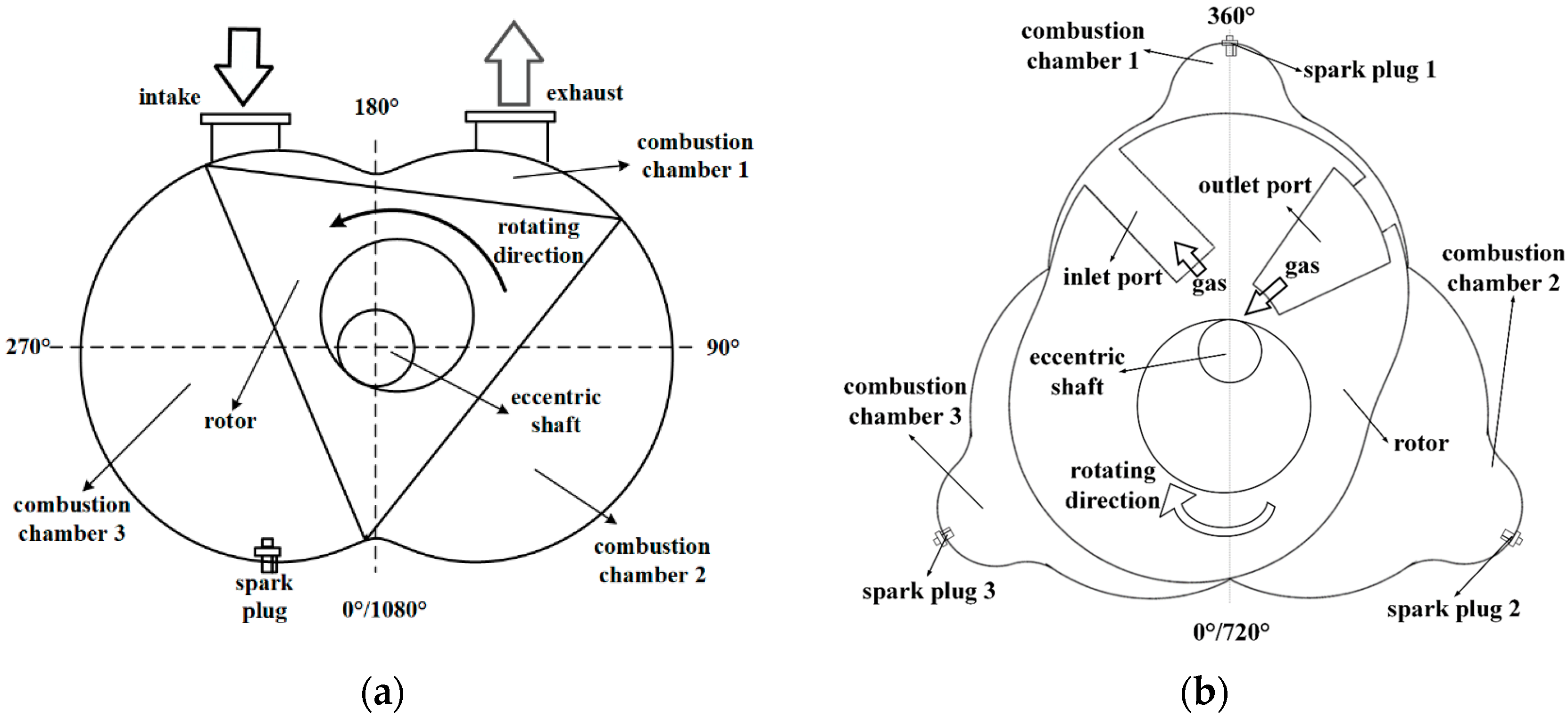
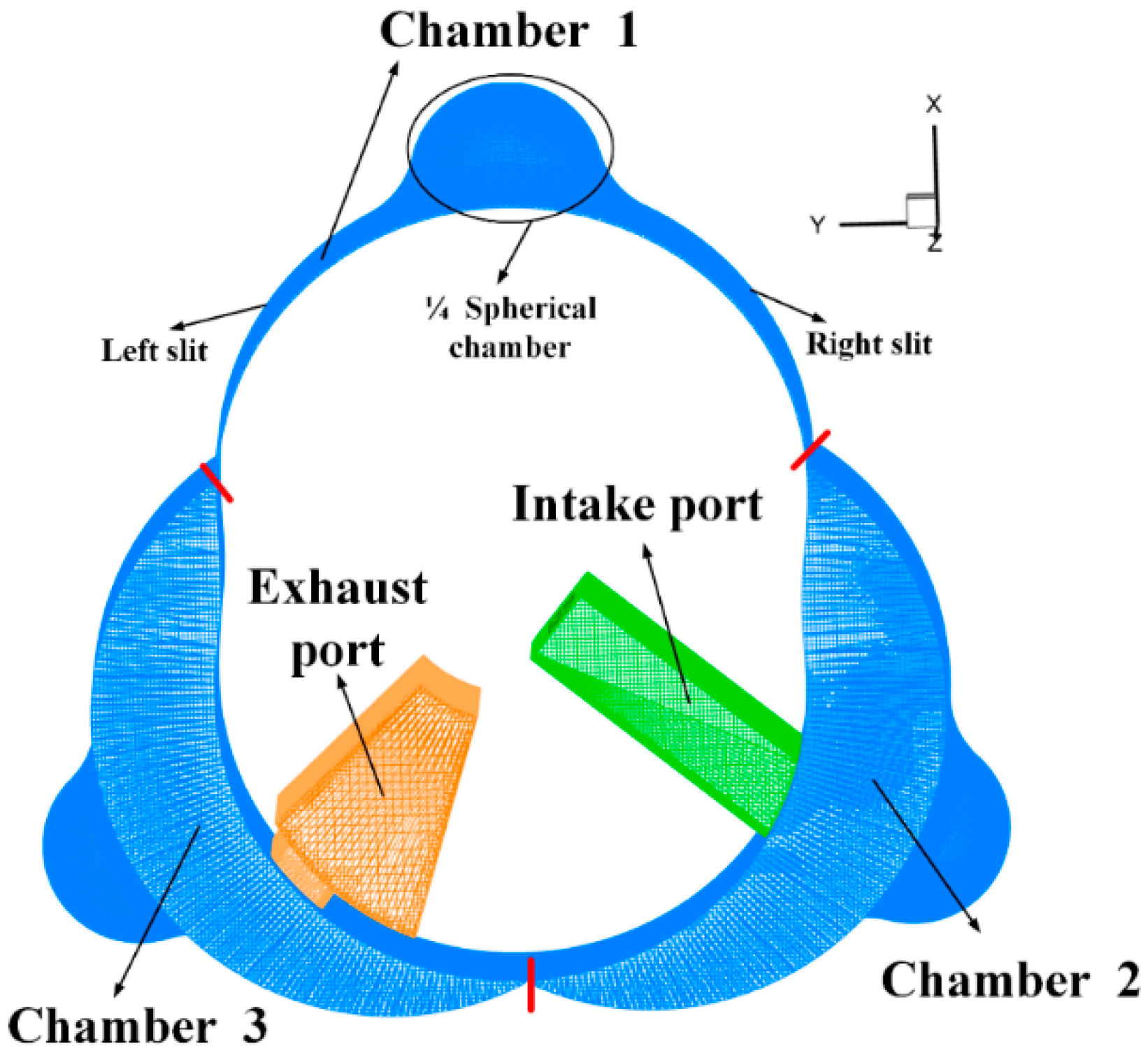
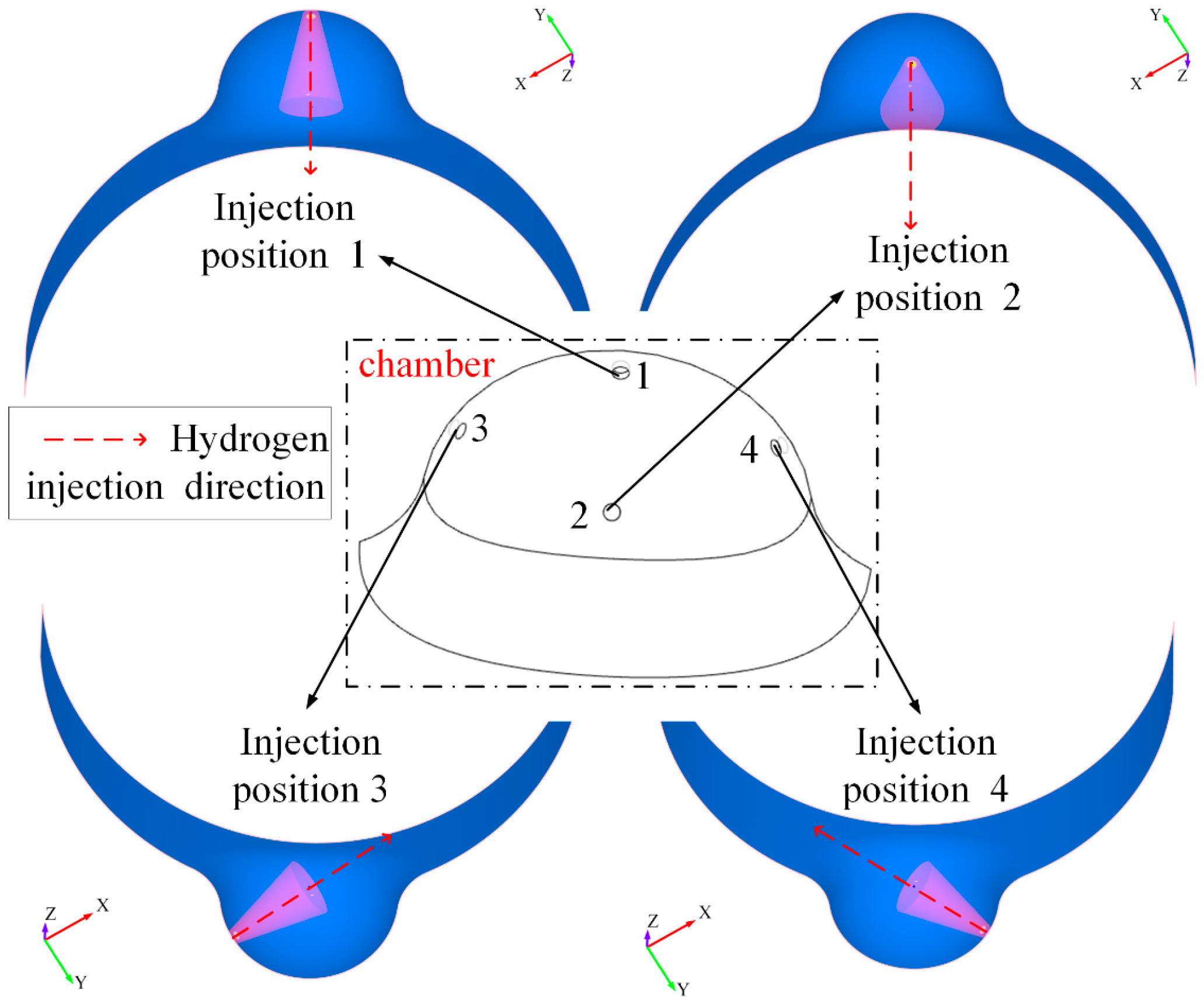

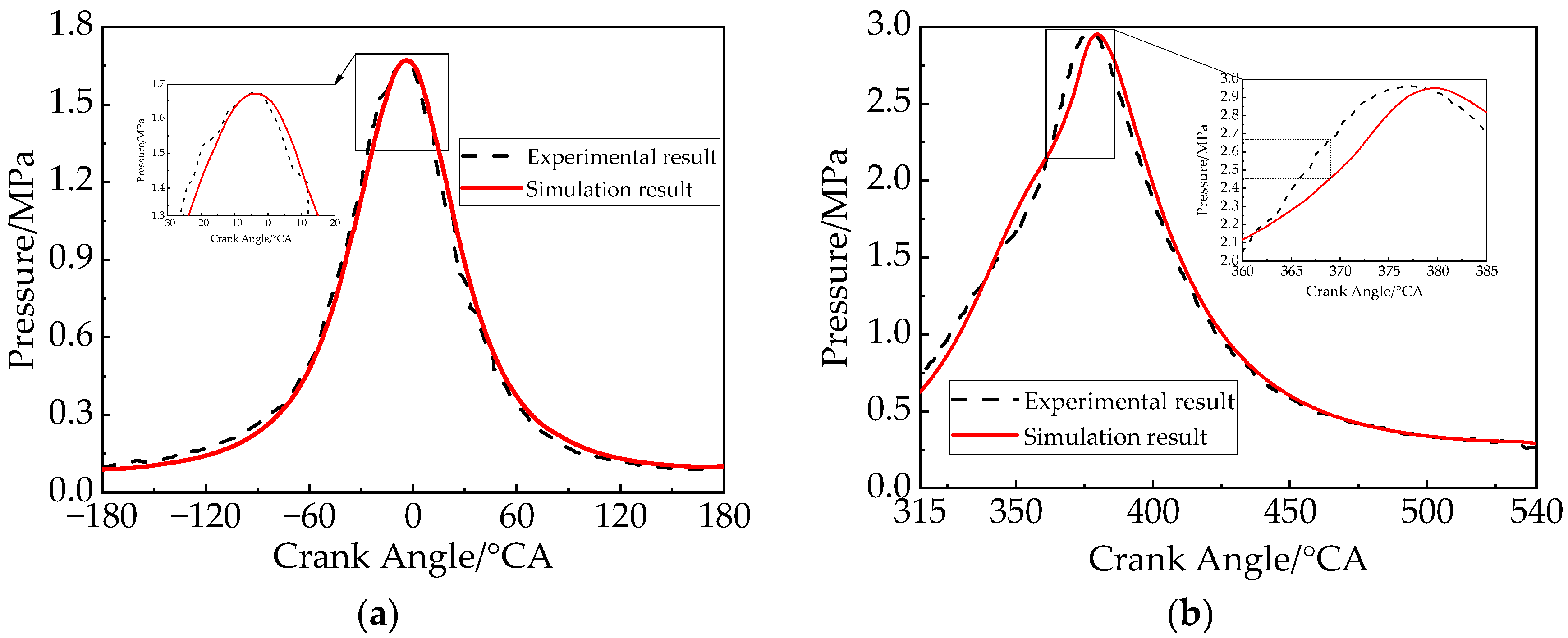
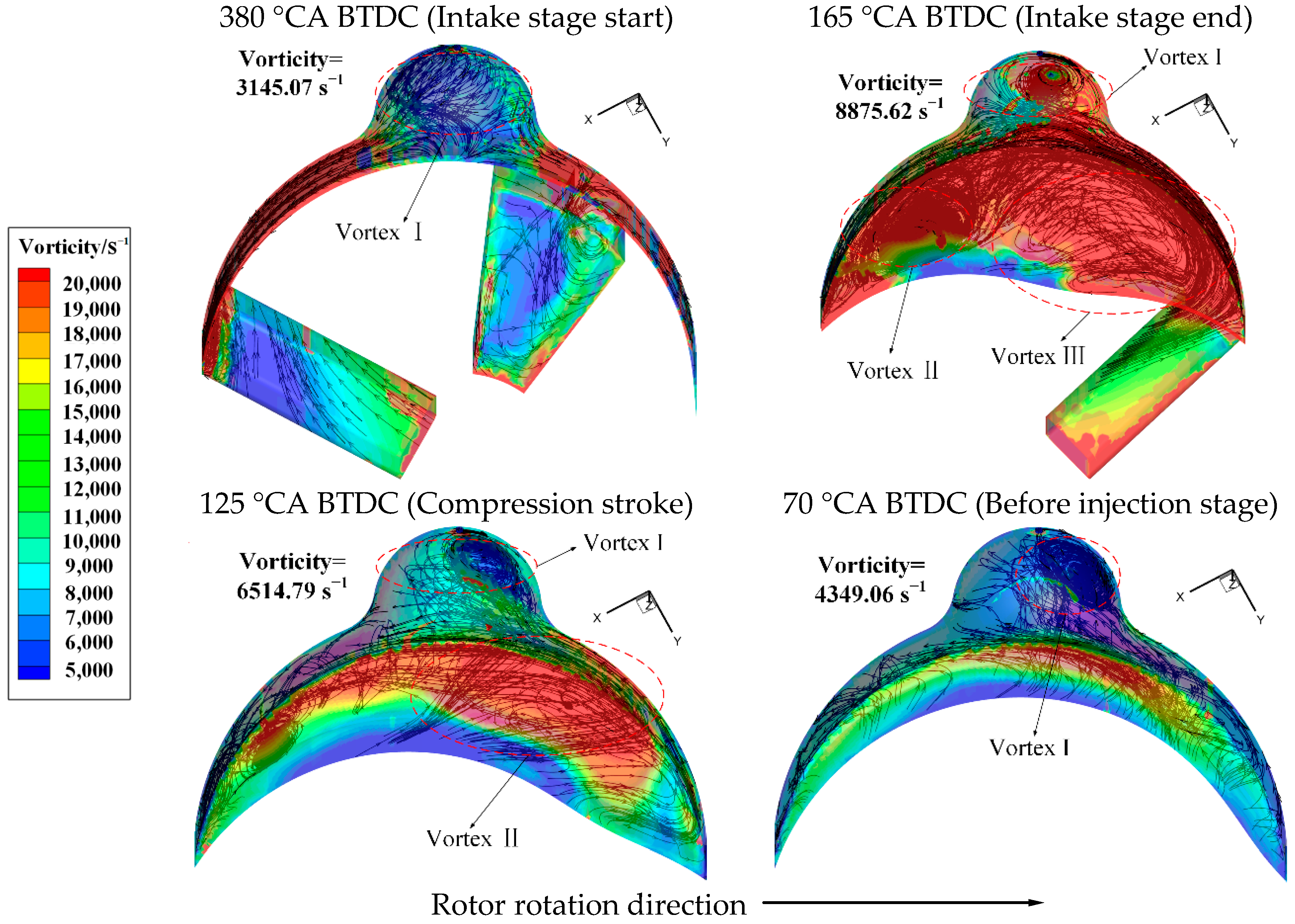
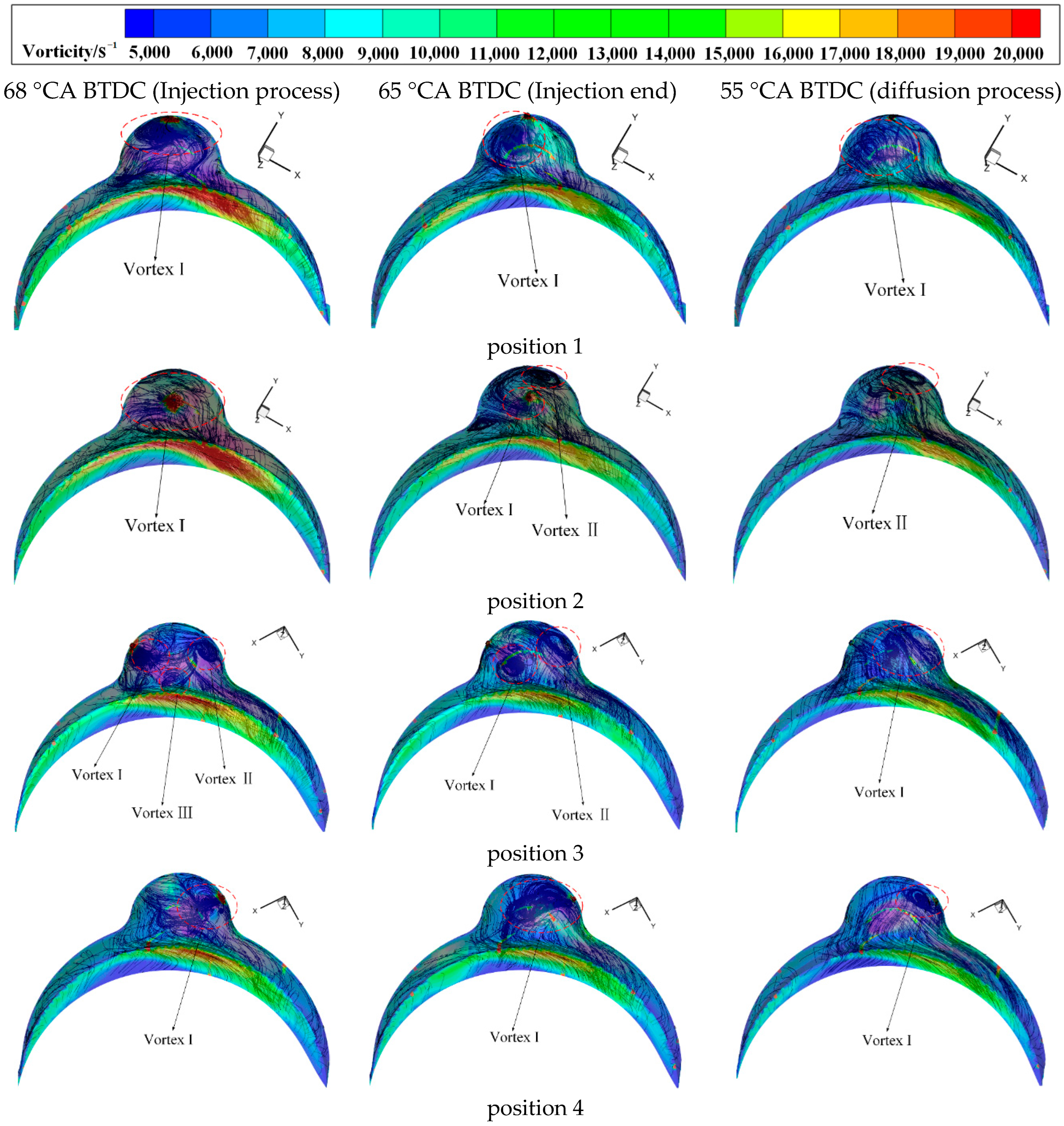
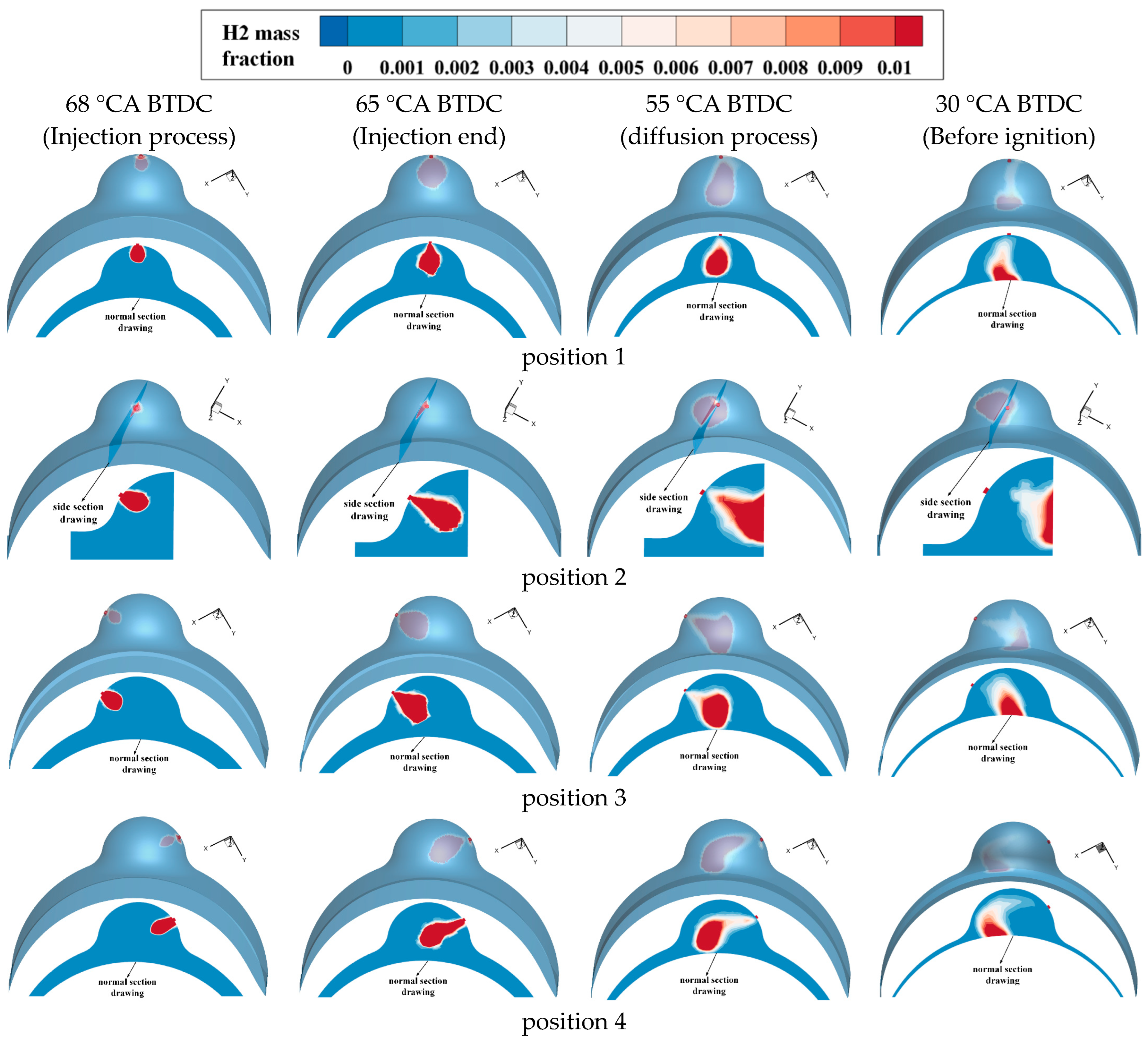
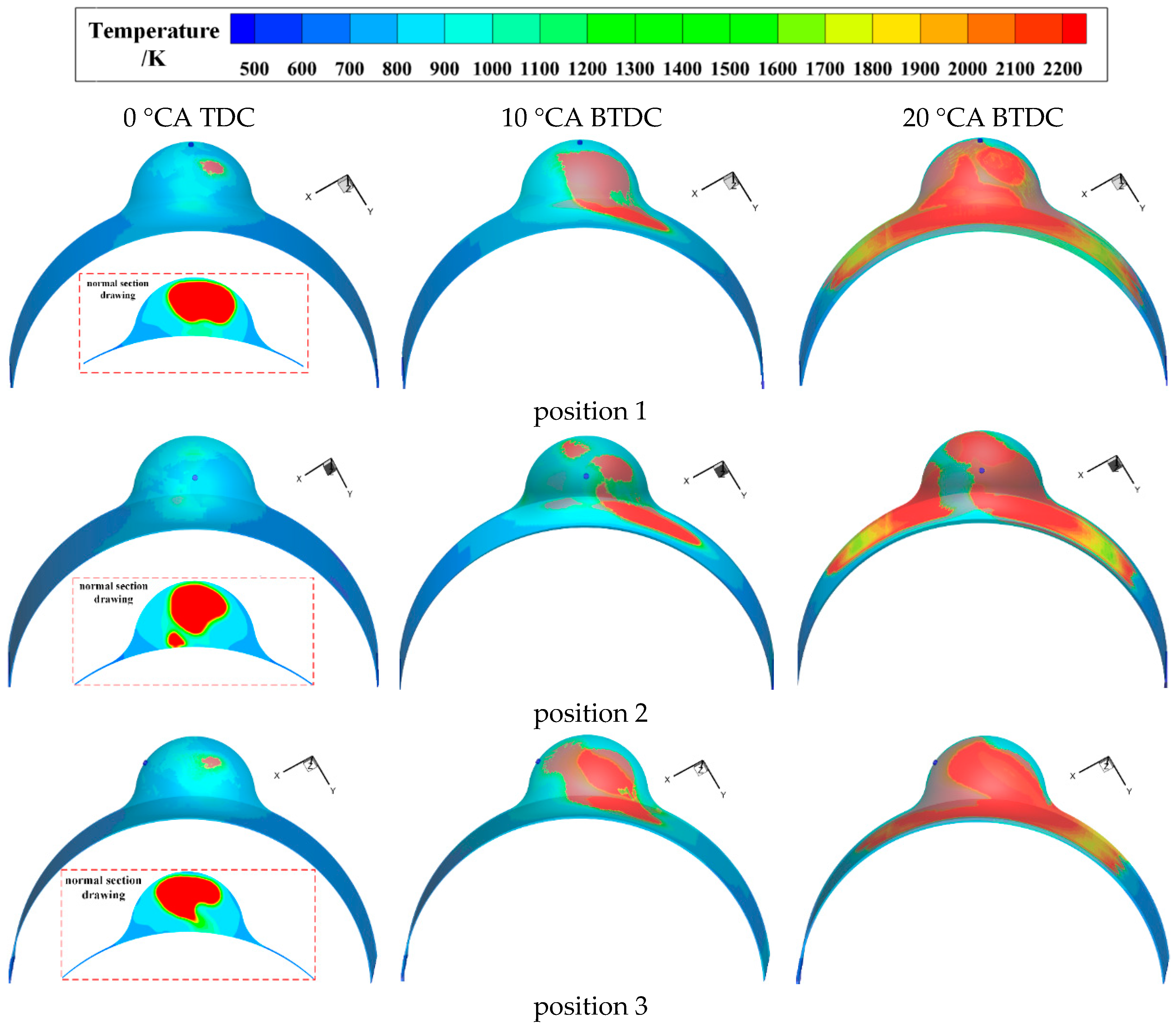

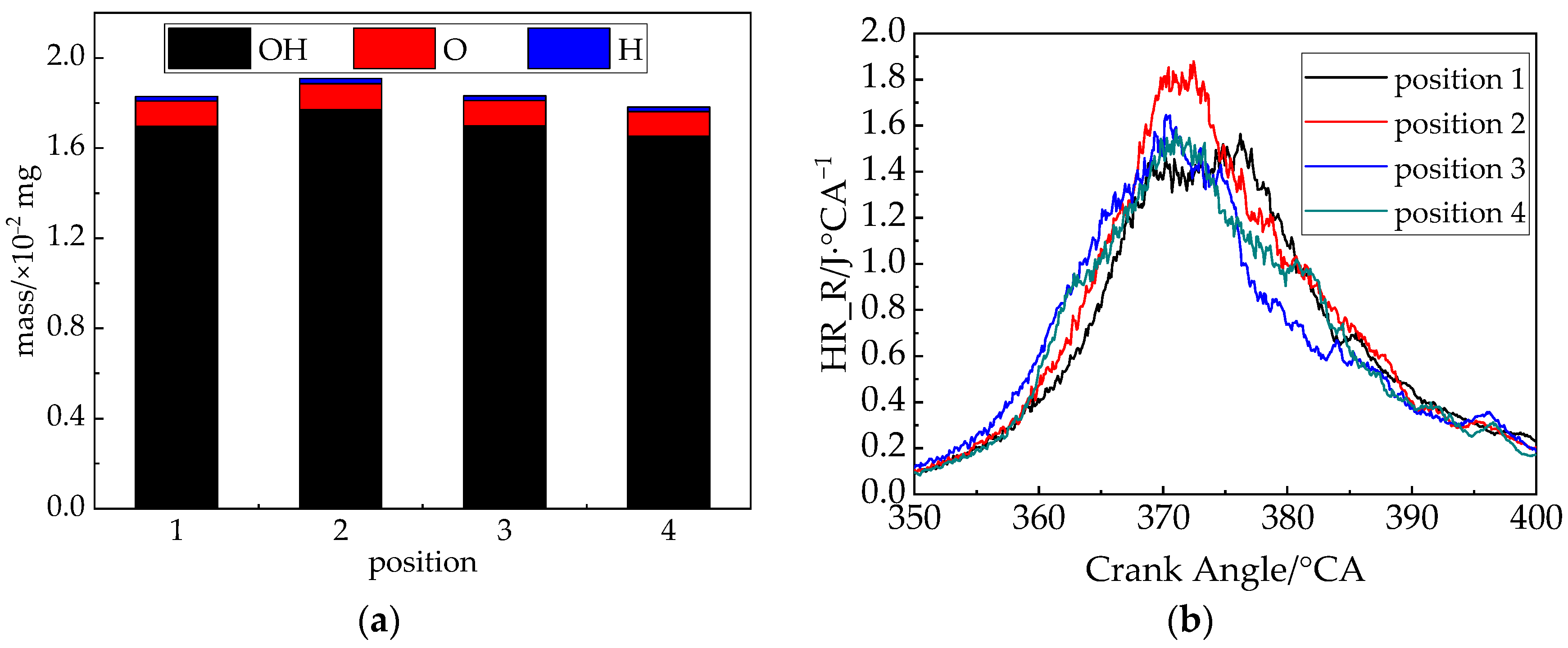
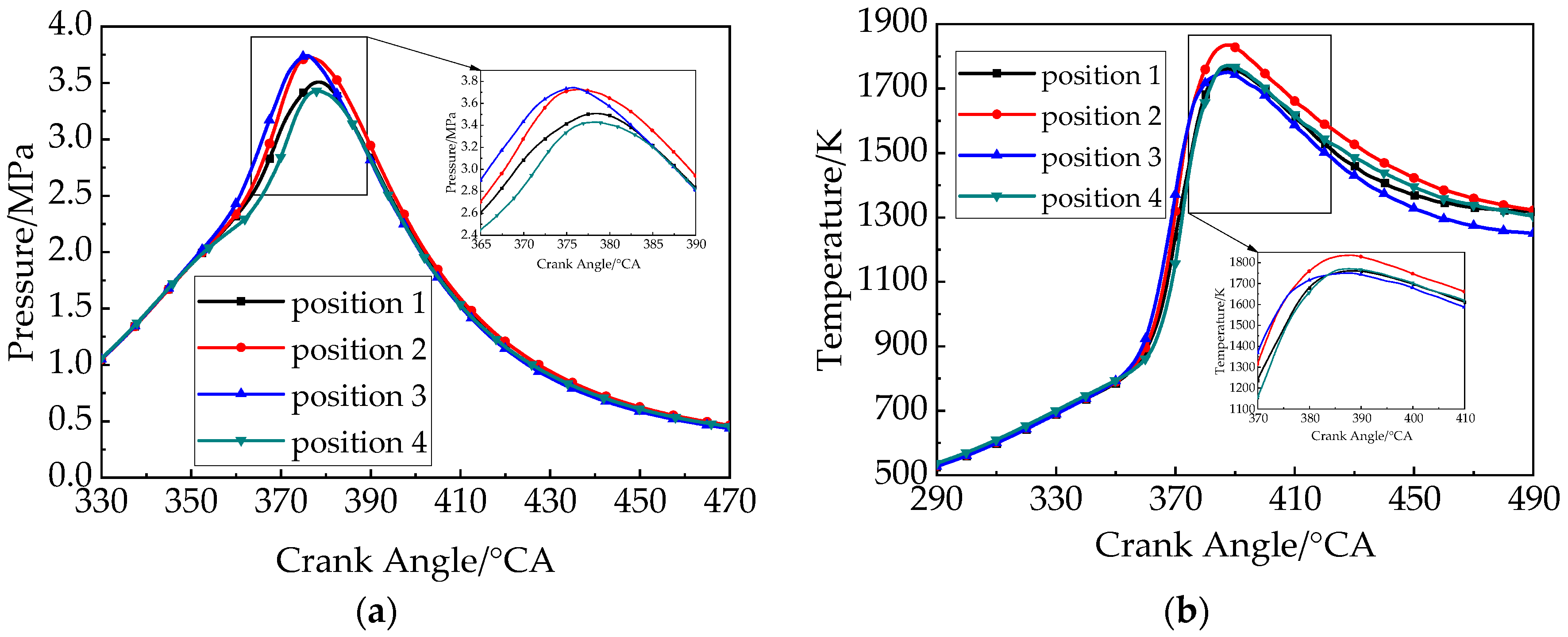
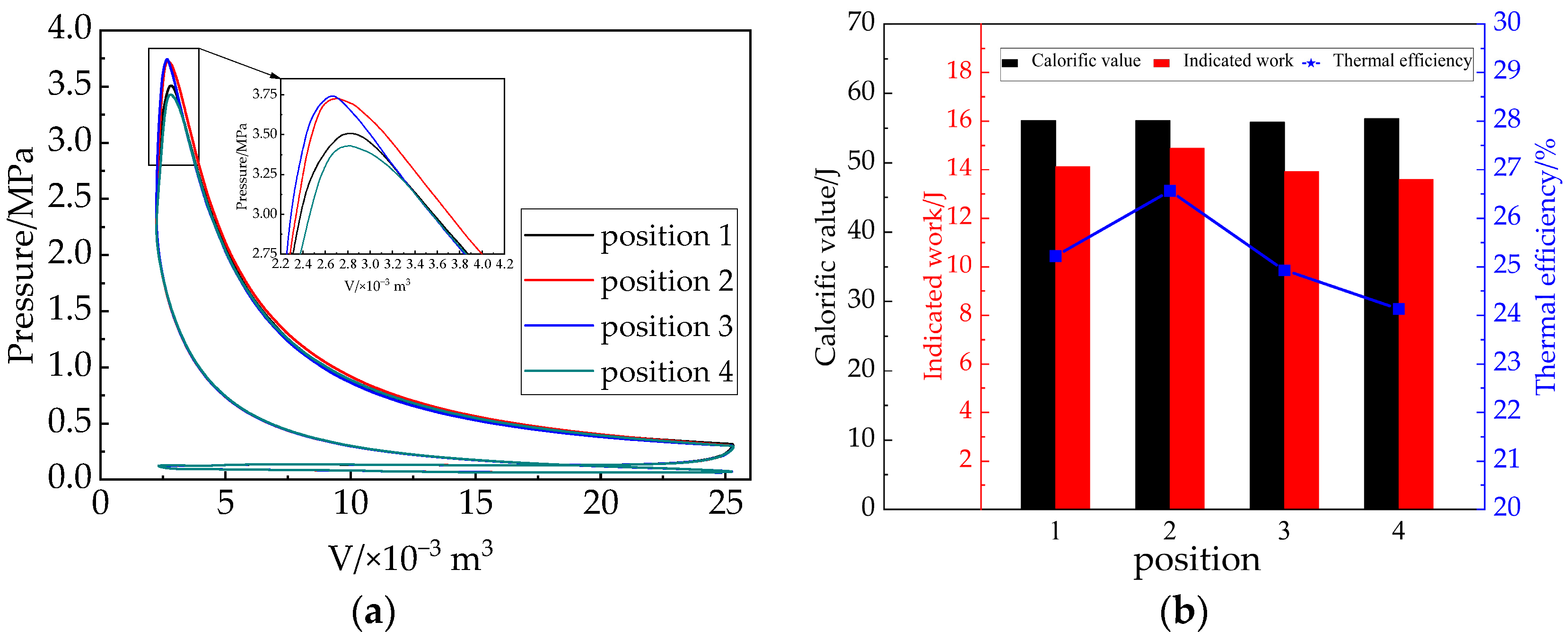
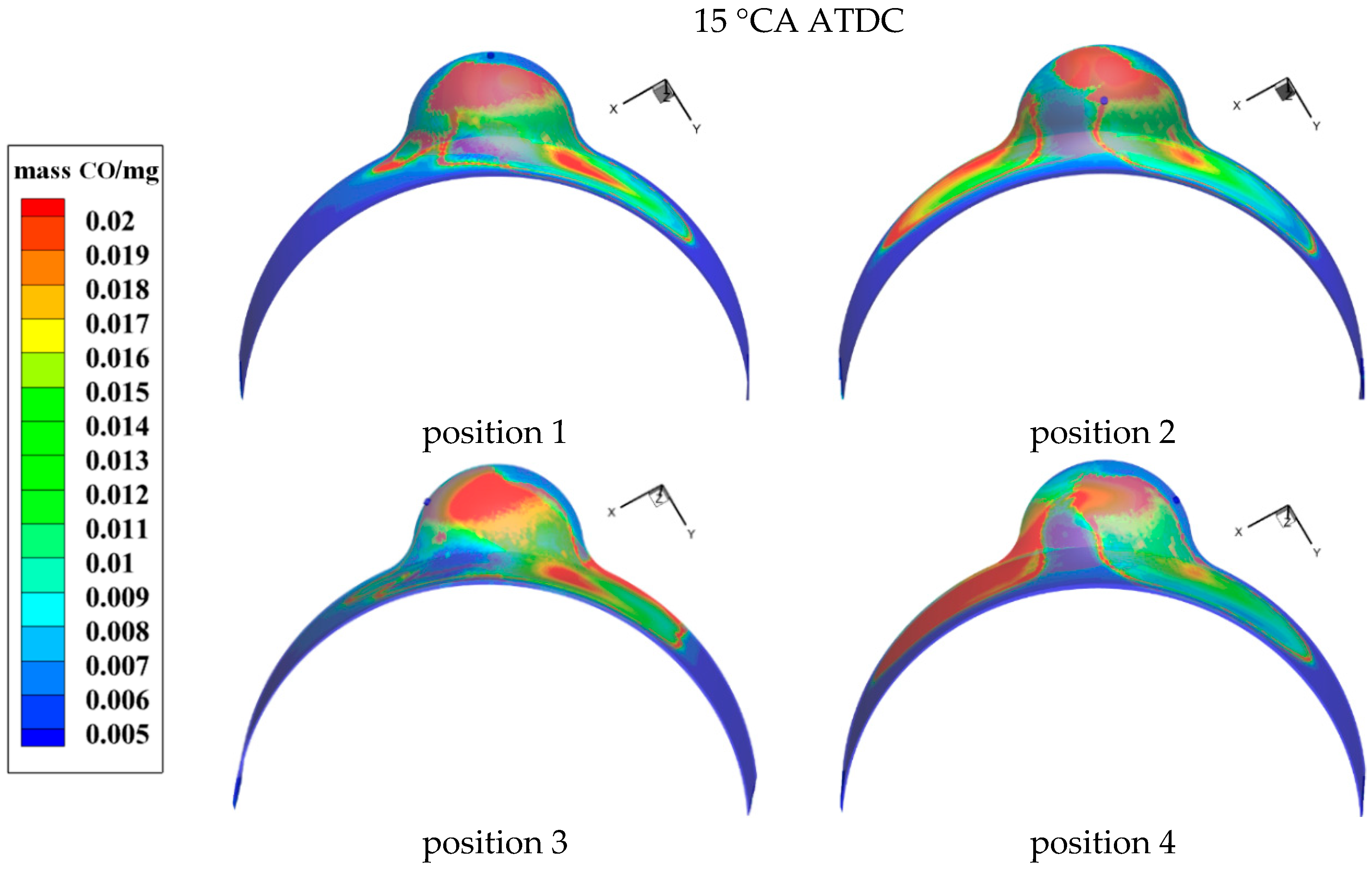
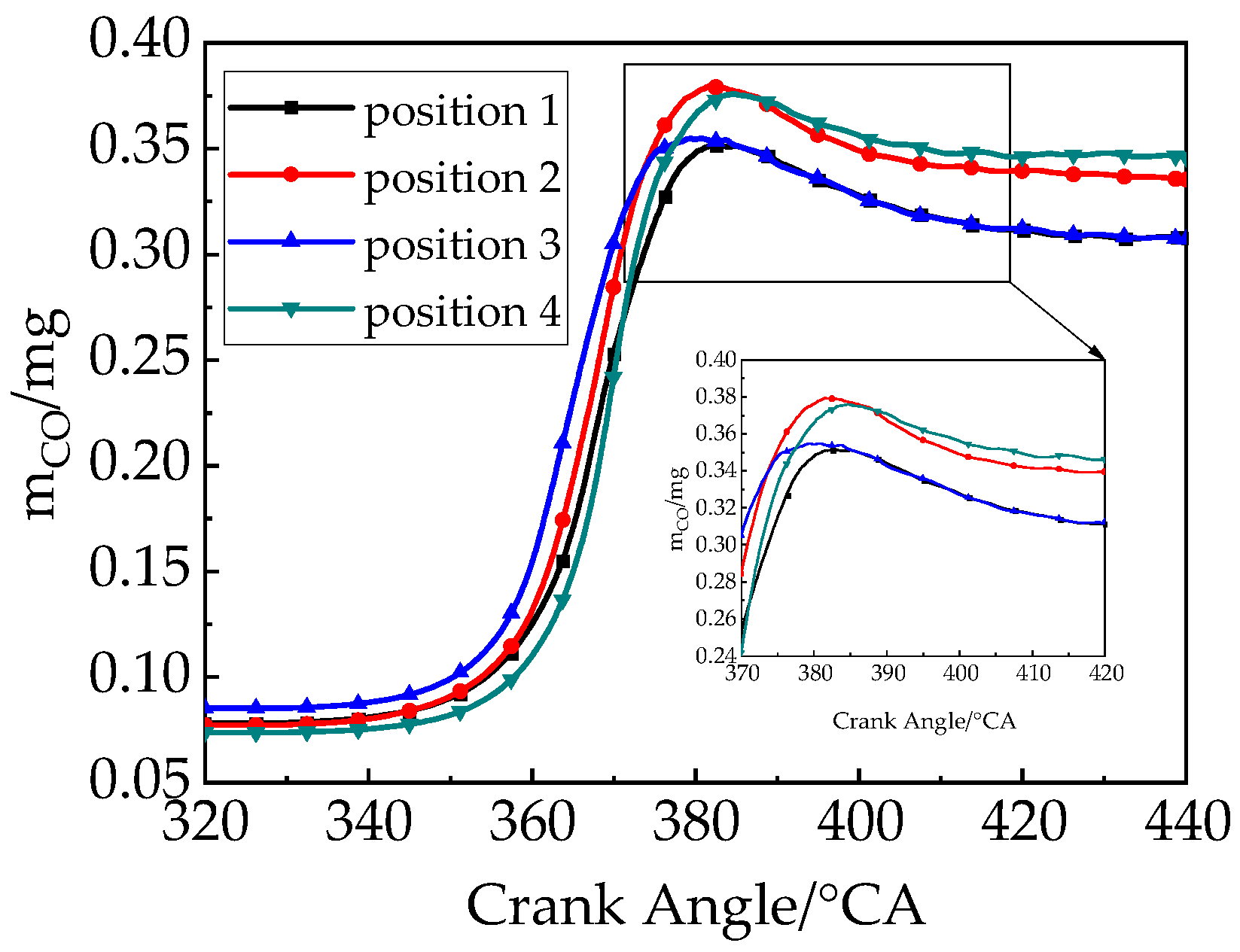

| Project | Value |
|---|---|
| Generating radius/mm | 41 |
| Eccentricity/mm | 6 |
| Cylinder thick/mm | 18.5 |
| Offset/mm | 0.7 |
| Geometry compression ratio | 11:1 |
| One chamber displacement/cc | 23 |
| Cooling method | Water cooled |
| Ignition source | Spark plug |
| Top dead center angle/°CA | 360 |
| Intake value closing/°CA | 585 |
| Exhaust value opening/°CA | 161 |
| Calculated Parameters | Value |
|---|---|
| Engine speed/RPM | 9000, 10,000 |
| Intake pressure/bar | 1.03 |
| Spark advance angle/°CA | 30 |
| Cooling gas flow to housing/kg·s−1 | 165 |
| Fuel | Gasoline, hydrogen–gasoline |
| Lambda | 0.85 |
| Specification Parameters | Value |
|---|---|
| Hydrogen energy fraction | 3% |
| Injection pressure | 0.5 MPa |
| Injection moment | 70 °CA BTDC |
| Injection pulse width | 3.5 °CA |
| Number of nozzles | 3 |
| Nozzle diameter | 1 mm |
Publisher’s Note: MDPI stays neutral with regard to jurisdictional claims in published maps and institutional affiliations. |
© 2022 by the authors. Licensee MDPI, Basel, Switzerland. This article is an open access article distributed under the terms and conditions of the Creative Commons Attribution (CC BY) license (https://creativecommons.org/licenses/by/4.0/).
Share and Cite
Geng, Q.; Wang, X.; Du, Y.; Yang, Z.; Wang, R.; He, G. Effect of the Hydrogen Injection Position on the Combustion Process of a Direct Injection X-Type Rotary Engine with a Hydrogen Blend. Energies 2022, 15, 7219. https://doi.org/10.3390/en15197219
Geng Q, Wang X, Du Y, Yang Z, Wang R, He G. Effect of the Hydrogen Injection Position on the Combustion Process of a Direct Injection X-Type Rotary Engine with a Hydrogen Blend. Energies. 2022; 15(19):7219. https://doi.org/10.3390/en15197219
Chicago/Turabian StyleGeng, Qi, Xuede Wang, Yang Du, Zhenghao Yang, Rui Wang, and Guangyu He. 2022. "Effect of the Hydrogen Injection Position on the Combustion Process of a Direct Injection X-Type Rotary Engine with a Hydrogen Blend" Energies 15, no. 19: 7219. https://doi.org/10.3390/en15197219
APA StyleGeng, Q., Wang, X., Du, Y., Yang, Z., Wang, R., & He, G. (2022). Effect of the Hydrogen Injection Position on the Combustion Process of a Direct Injection X-Type Rotary Engine with a Hydrogen Blend. Energies, 15(19), 7219. https://doi.org/10.3390/en15197219






